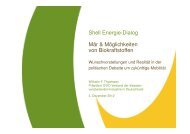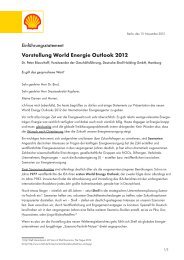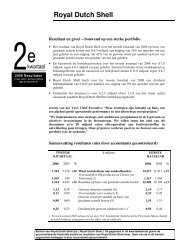62414 sustain 40pp (Mag)
62414 sustain 40pp (Mag)
62414 sustain 40pp (Mag)
Create successful ePaper yourself
Turn your PDF publications into a flip-book with our unique Google optimized e-Paper software.
Environmental permitting<br />
In October 2006, the Russian environment<br />
agency threatened to suspend crucial licences,<br />
citing violations of environmental permits.<br />
These alleged violations would not have caused<br />
long-term environmental damage. Sakhalin<br />
Energy developed an Environmental Action<br />
Plan which, after further refinement, was resubmitted<br />
to the authorities in March 2007 for<br />
further review.<br />
Sustainable benefits for local people<br />
Sakhalin Energy is actively helping islanders<br />
benefit from oil and gas development. In<br />
addition to the $100 million it contributed<br />
to the regional government’s Sakhalin<br />
Development Fund, $390 million is being spent<br />
upgrading and building new infrastructure on<br />
the Island.<br />
By the end of 2006, 17,000 staff and<br />
contractors, nearly 7,000 of them local, were<br />
working on Sakhalin II. Once construction<br />
ends, employment and business activities from<br />
the project will be lower.<br />
Nonetheless, Sakhalin II is expected to employ<br />
about 2,400 permanent staff and create work<br />
for approximately 7,000 local contractors and<br />
suppliers. Managing the transition is a priority<br />
for the Island and for Sakhalin Energy.<br />
Indigenous people<br />
Large-scale energy developments pose<br />
challenges for the Island’s 3,500 indigenous<br />
people. Sakhalin Energy was the first company<br />
to support and work with the democratically<br />
elected Sakhalin Indigenous Minorities Council<br />
that was formed in 2005 to represent this<br />
group. In 2006, the Council, regional<br />
government and Sakhalin Energy launched<br />
the first five-year Indigenous Minorities<br />
Development Plan. Developed with advice<br />
from the World Bank, the plan identifies<br />
practical ways to mitigate impacts from oil and<br />
gas development on indigenous people and<br />
promote traditional livelihoods and <strong>sustain</strong>able<br />
businesses. Sakhalin Energy is providing the<br />
funding ($1.5 million) and is a member of the<br />
supervisory groups charged with making sure<br />
the plan is carried out.<br />
Project financing<br />
Gazprom’s entry and the change of shareholdings<br />
may alter the way the project is financed. As a<br />
result, the European Bank for Reconstruction<br />
and Development (EBRD) ended its review of<br />
the current funding proposal in early 2007.<br />
[Editor: text finalised 2007, while the joint<br />
ventures’ negotiations with Gazprom were<br />
still underway].<br />
Additional web content:<br />
www.sakhalinenergy.com<br />
VOICES “ ”<br />
RIVER CROSSING OBSERVER<br />
For the last two winters, I have worked as<br />
one of the independent observers for<br />
Sakhalin Energy’s river crossing<br />
programme. We have monitored the<br />
pipeline construction where it crosses<br />
ecologically sensitive rivers, have publicly<br />
reported on construction practices, and<br />
have provided advice to the project’s<br />
pipeline engineers. We have had<br />
unrestricted access to the crossings we<br />
are monitoring and freedom to report<br />
honestly on what we saw. In my opinion,<br />
Sakhalin Energy has taken the challenge<br />
of getting its contractors to comply with<br />
its standards seriously. Compliance has<br />
steadily improved, reducing<br />
environmental impacts.<br />
Mark Dunnigan<br />
AQUATIC BIOLOGIST<br />
GOLDER ASSOCIATES LTD<br />
THE SHELL SUSTAINABILITY REPORT 2006 35





![Download Shell AutoGas Stationen [Stand: Januar 2013] (PDF](https://img.yumpu.com/9982753/1/190x245/download-shell-autogas-stationen-stand-januar-2013-pdf.jpg?quality=85)











